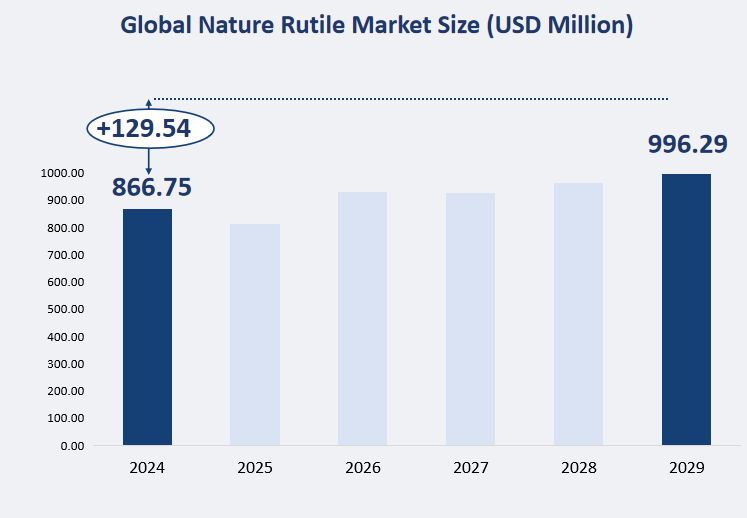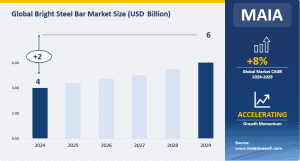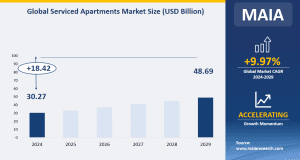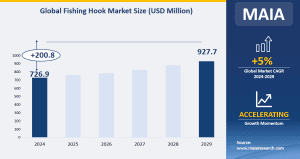Asia Pacific region dominates the nature rutile market in terms of consumption, with a share of approximately 37.84% in 2024.

Definition
Nature Rutile is a mineral whose main component is titanium dioxide. It forms red to reddish brown, hard, brilliant metallic, slender crystals, often completely surrounded by other minerals.
Market by Type
Based on Type, the nature rutile market is divided into high grade and low grade. Among them, high grade dominates the market, accounting for about 92.20% of the revenue share. According to the titanium dioxide content, the titanium dioxide content of more than 92% is called high grade rutile, and the carbon dioxide content of less than 92% is called low grade rutile.
Market by Application
Based on Application, the natural rutile market is divided into TiO2 pigment, welding flux and titanium metal manufacturing. Among them, TiO2 pigment has the highest consumption, accounting for about 84.38%, followed by titanium metal manufacturing, accounting for about 10.06%. Titanium dioxide pigment is mainly used as white pigment. Titanium welding is mainly used in welding electrode field; Titanium metal manufacturing is mainly used for the production of titanium materials, such as titanium sponge, titanium ingot, metal titanium and so on.
Regional Analysis and Insights
The consumption of natural rutile in the Asia-Pacific region dominates the market, accounting for about 37.84%, followed by North America, accounting for about 34.74%. Increasing demand for rutile in the production of titanium metal and paint pigments and growing construction activities in developing countries such as China and India will drive the development of rutile in Asia Pacific.
Market Trends
‘Sustainability in the mining industry’
The mining industry provides energy and raw materials for the development of other industries and economies of the national economy. In recent years, as the global economy has entered a new normal and the society has called for the construction of a resource-saving society, the mining industry, as a basic industry supporting the national economy, must enter a period of deep adjustment, and it is necessary to pay attention to the rational exploitation of mineral resources while pursuing economic interests, so as to achieve its own sustainable development. In response to the problems existing in the mining industry, in recent years, various national governments or relevant departments have issued a series of policies and guidelines to guide the standardized, green and sustainable development of the mining industry. At the international level, ESG requirements in some countries have gradually changed from loose guidelines to mandatory regulations, and ESG reporting has become an obligation that mining companies must comply with. Many national government agencies and non-profit associations are also aware of and beginning to grasp the opportunities for sustainable development by issuing research reports and policy guidelines to participate in the sustainable development of the mining industry.
Market Drivers
‘Terminal industry demand is extensive and steady growth’
Rutile is one of the main sources of titanium, natural rutile is mainly used in the manufacture of titanium dioxide pigment, flux, titanium metal. In downstream applications, titanium dioxide pigments occupy a major market share. Titanium dioxide pigment is mainly titanium dioxide, titanium dioxide has a high refractive index, ideal particle size distribution, good covering power and coloring power, widely used in coatings, plastics, paper, rubber, chemical fiber, cosmetics, medicine, electronics industry, micro-electromechanical, environmental protection industry and so on. Titanium welding is mainly used in metallurgy and other industrial sectors. Titanium metal has low density, high specific strength, corrosion resistance, low expansion coefficient, low thermal conductivity, non-magnetic, good physiological compatibility, strong surface magnetism, but also has special functions such as hydrogen storage, superconductivity, shape memory, superelasticity and high damping. Titanium is a high quality functional material and an important biomedical material, and its downstream applications are widely distributed. Therefore, in recent years, due to the growth of downstream demand, the demand for titanium continues to grow, promoting the growth of natural rutile demand, making the global natural rutile production continues to grow.
‘Development of preparation technology of titanium dioxide’
In the downstream application division, titanium dioxide occupies a large market share in rutile applications. Titanium dioxide is one of the most complex inorganic chemical products. The main methods of industrial preparation of titanium dioxide are sulfation and chlorination, of which chlorination production of titanium dioxide is mainly used in high titanium slag or artificial rutile. Sulphuric acid products can cover all downstream applications. And the sulfuric acid process is more mature, but the process flow is more complicated. Sulfuric acid process through sulfuric acid to decompose titanium ore, through filtration, hydrolysis, calcination, grinding and other processes to obtain titanium dioxide, can produce rutile titanium dioxide. Nowadays, with the development of industrial technology and the enhancement of social environmental protection awareness, titanium dioxide sulfate process automation, product serialization, specialization, greatly improved environmental friendliness, titanium dioxide product quality greatly improved, production efficiency greatly improved, the traditional sulfuric acid production process gradually to co-production clean process transformation. It is expected that the future sulfuric acid process will further develop in the direction of waste by-product recycling, low emission or zero emission. With the growth of demand for titanium dioxide and the optimization of production processes, the development of the industry is driven.
Market Challenges
‘Higher capital investment’
Natural rutile industry belongs to the ore industry, this industry is a resource-intensive and labor-intensive industry, in general, the industry enterprises need to invest a lot of money for mining, ore smelting and so on. The cost of ore mining mainly has three parts: the cost of mining rights, the cost of mining operations and the cost of facilities such as excavators and drilling RIGS. In addition, natural rutile is divided into rock ore and placer ore, of which the ore is mainly hornblende containing rutile and garnet, the rock ore contains rutile 2.29-2.42%, the highest is 4.89-643%, generally accompanied by apatite, titanite, zircon and so on. Sand ore is generally deficient, coastal, impact type, etc., the content of rutile is generally 1.10-3.87%, the highest is 4.70-8.37%, generally accompanied by iron ore, zircon, apatite. Therefore, the composition and distribution of most rutile ore deposits are chaotic, the grade is low and the particle size is fine, and the selection ability of the useful mineral deposits associated with the primary is small, and the beneficiation process is chaotic, resulting in greater mining and smelting costs. Beneficiation process is the preparation work before ore smelting, after mining the ore, it is first necessary to select the ore with high metal elements to prepare for the next smelting activity. Mineral processing is generally divided into crushing, grinding, separation of three parts. Among them, the crushing is divided into: coarse breaking, medium breaking and fine breaking; According to the different ways can also be divided into: magnetic separation, gravity separation, flotation and so on. Reasonable and scientific beneficiation process is closely related to product recovery and cost. And the gold red ore generally has the characteristics of low induction utilization rate, difficult sorting skills and so on. The cost of early mining and smelting of natural rutile is relatively large, which is one of the main challenges faced by enterprises in the industry.
‘The effects of the Russo-Ukrainian war’
Ukraine is one of the main producers of natural rutile, a high-quality titanium raw material used in markets such as pigments, aerospace and welding. It is also an extremely tight market, and while there is a persistent demand for the product, global supply is dwindling due to the lack discovered in recent years. When COVID-19 hit in early 2020, Sierra Leone’s government closed its borders for six months to protect one of the world’s most vulnerable healthcare systems. Sierra Leone is also one of the major producers of natural rutile. The lockdown policy of the new coronavirus epidemic has led to the disruption of the supply chain of the titanium industry, and the import and export of upstream raw materials has been blocked, making the price of raw materials rise, that is, the price of natural rutile rise. And due to the disruption of the supply chain, the industry supply and demand imbalance, the global market of natural rutile supply shortage is serious. The Russia-Ukraine war not only exacerbated the negative macroeconomic impact caused by the epidemic, such as intensifying global inflation, labor market imbalances, consumer confidence, etc., but also caused Ukraine to disrupt the supply chain of titanium raw materials and titanium finished products, severely affecting a large number of rutile exports for pigment manufacturing, exacerbating the global shortage of natural rutile supply. In addition, the industry enterprises in the Ukraine region due to the impact of the war, so that their income fell, sales fell, profits fell. The Russia-Ukraine war has caused disruptions to the rutile supply chain and exacerbated supply shortages, which may cause certain price fluctuations for rutile prices, thereby affecting the entire titanium industry.
Top Companies
The natural rutile market is highly competitive, with major players including Tronox Limited, Sierra Rutile Limited, Rio Tinto, Base Resources, Iluka Resources Limited (Exclude Sierra Rutile) and V.V Mineral. The top 5 companies account for approximately 86.22% of the revenue share.
Market Scope
| Coverage | Detail |
| Market Size in 2024 | 866.75 million USD |
| Market Size in 2029 | 996.29 million USD |
| High Grade Segment Market Share in 2024 | 92.20% |
| TiO2 Pigment Segment Consumption Share in 2024 | 84.38% |
| Titanium Metal Manufacturing Segment Consumption Share in 2024 | 10.06% |
| Asia-Pacific Consumption Share in 2024 | 37.84% |
| North America Consumption Share in 2024 | 34.74% |
| Top 5 Companies Revenue Share | 86.22% |




